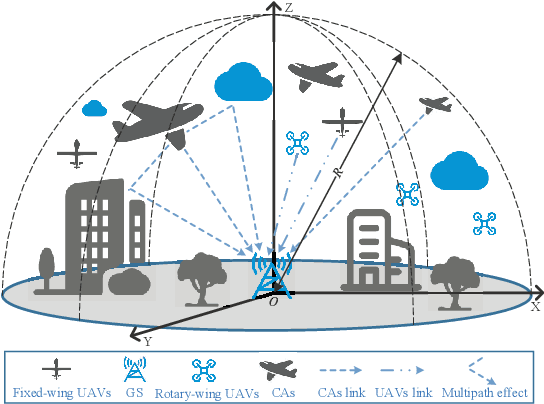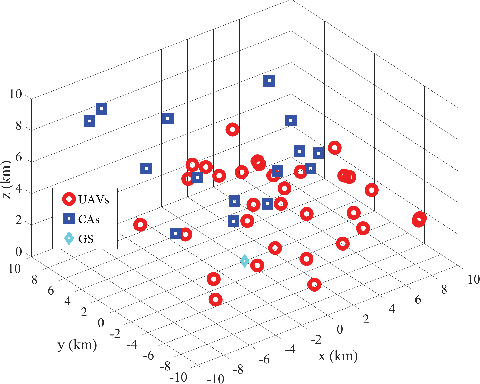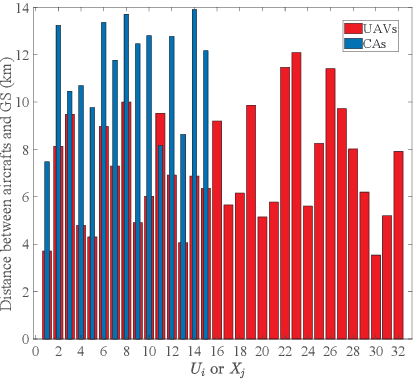Yiyang Liao
Joint ADS-B in B5G for Hierarchical UAV Networks: Performance Analysis and MEC Based Optimization
Mar 18, 2025Abstract:Unmanned aerial vehicles (UAVs) play significant roles in multiple fields, which brings great challenges for the airspace safety. In order to achieve efficient surveillance and break the limitation of application scenarios caused by single communication, we propose the collaborative surveillance model for hierarchical UAVs based on the cooperation of automatic dependent surveillance-broadcast (ADS-B) and 5G. Specifically, UAVs are hierarchical deployed, with the low-altitude central UAV equipped with the 5G module, and the high-altitude central UAV with ADS-B, which helps automatically broadcast the flight information to surrounding aircraft and ground stations. Firstly, we build the framework, derive the analytic expression, and analyze the channel performance of both air-to-ground (A2G) and air-to-air (A2A). Then, since the redundancy or information loss during transmission aggravates the monitoring performance, the mobile edge computing (MEC) based on-board processing algorithm is proposed. Finally, the performances of the proposed model and algorithm are verified through both simulations and experiments. In detail, the redundant data filtered out by the proposed algorithm accounts for 53.48%, and the supplementary data accounts for 16.42% of the optimized data. This work designs a UAV monitoring framework and proposes an algorithm to enhance the observability of trajectory surveillance, which helps improve the airspace safety and enhance the air traffic flow management.
Interference Analysis for Coexistence of UAVs and Civil Aircrafts Based on Automatic Dependent Surveillance-Broadcast
Jun 12, 2024



Abstract:Due to the advantages of high mobility and easy deployment, unmanned aerial vehicles (UAVs) are widely applied in both military and civilian fields. In order to strengthen the flight surveillance of UAVs and guarantee the airspace safety, UAVs can be equipped with the automatic dependent surveillance-broadcast (ADS-B) system, which periodically sends flight information to other aircrafts and ground stations (GSs). However, due to the limited resource of channel capacity, UAVs equipped with ADS-B results in the interference between UAVs and civil aircrafts (CAs), which further impacts the accuracy of received information at GSs. In detail, the channel capacity is mainly affected by the density of aircrafts and the transmitting power of ADS-B. Hence, based on the three-dimensional poisson point process, this work leverages the stochastic geometry theory to build a model of the coexistence of UAVs and CAs and analyze the interference performance of ADS-B monitoring system. From simulation results, we reveal the effects of transmitting power, density, threshold and pathloss on the performance of the ADS-B monitoring system. Besides, we provide the suggested transmitting power and density for the safe coexistence of UAVs and CAs.
Joint ADS-B in 5G for Hierarchical Aerial Networks: Performance Analysis and Optimization
Apr 29, 2024Abstract:Unmanned aerial vehicles (UAVs) are widely applied in multiple fields, which emphasizes the challenge of obtaining UAV flight information to ensure the airspace safety. UAVs equipped with automatic dependent surveillance-broadcast (ADS-B) devices are capable of sending flight information to nearby aircrafts and ground stations (GSs). However, the saturation of limited frequency bands of ADS-B leads to interferences among UAVs and impairs the monitoring performance of GS to civil planes. To address this issue, the integration of the 5th generation mobile communication technology (5G) with ADS-B is proposed for UAV operations in this paper. Specifically, a hierarchical structure is proposed, in which the high-altitude central UAV is equipped with ADS-B and the low-altitude central UAV utilizes 5G modules to transmit flight information. Meanwhile, based on the mobile edge computing technique, the flight information of sub-UAVs is offloaded to the central UAV for further processing, and then transmitted to GS. We present the deterministic model and stochastic geometry based model to build the air-to-ground channel and air-to-air channel, respectively. The effectiveness of the proposed monitoring system is verified via simulations and experiments. This research contributes to improving the airspace safety and advancing the air traffic flow management.
Impact of UAVs Equipped with ADS-B on the Civil Aviation Monitoring System
Jul 04, 2023Abstract:In recent years, there is an increasing demand for unmanned aerial vehicles (UAVs) to complete multiple applications. However, as unmanned equipments, UAVs lead to some security risks to general civil aviations. In order to strengthen the flight management of UAVs and guarantee the safety, UAVs can be equipped with automatic dependent surveillance-broadcast (ADS-B) devices. In addition, as an automatic system, ADS-B can periodically broadcast flight information to the nearby aircrafts or the ground stations, and the technology is already used in civil aviation systems. However, due to the limited frequency of ADS-B technique, UAVs equipped with ADS-B devices result in the loss of packets to both UAVs and civil aviation. Further, the operation of civil aviation are seriously interfered. Hence, this paper firstly examines the packets loss of civil planes at different distance, then analyzes the impact of UAVs equipped with ADS-B on the packets updating of civil planes. The result indicates that the 1090MHz band blocking is affected by the density of UAVs. Besides, the frequency capacity is affected by the requirement of updating interval of civil planes. The position updating probability within 3s is 92.3% if there are 200 planes within 50km and 20 UAVs within 5km. The position updating probability within 3s is 86.9% if there are 200 planes within 50km and 40 UAVs within 5km.
 Add to Chrome
Add to Chrome Add to Firefox
Add to Firefox Add to Edge
Add to Edge